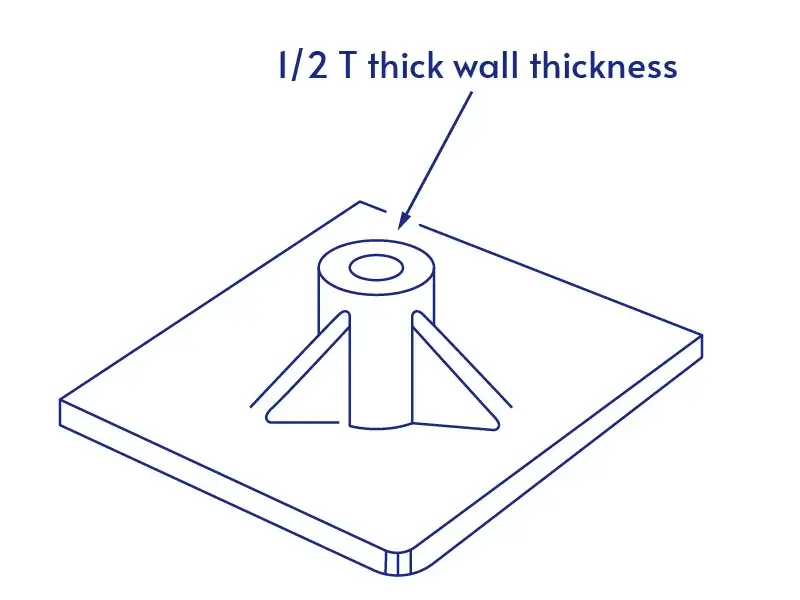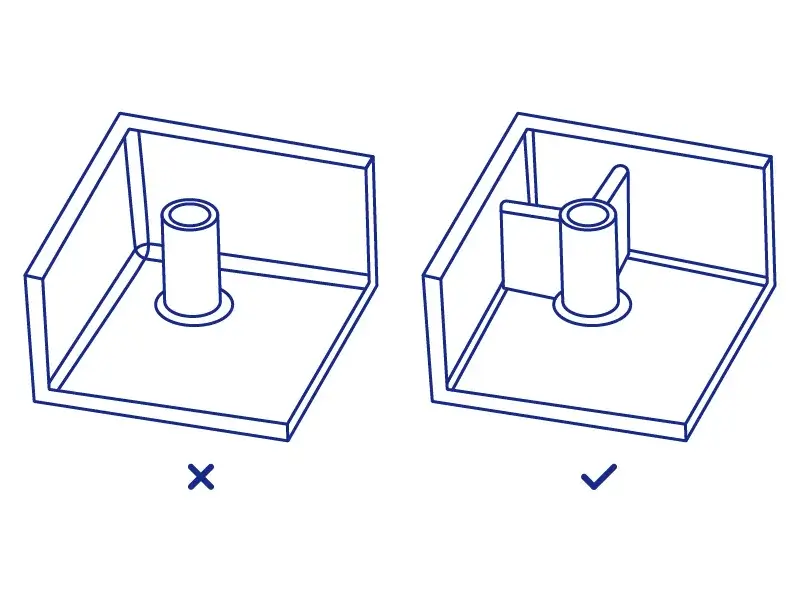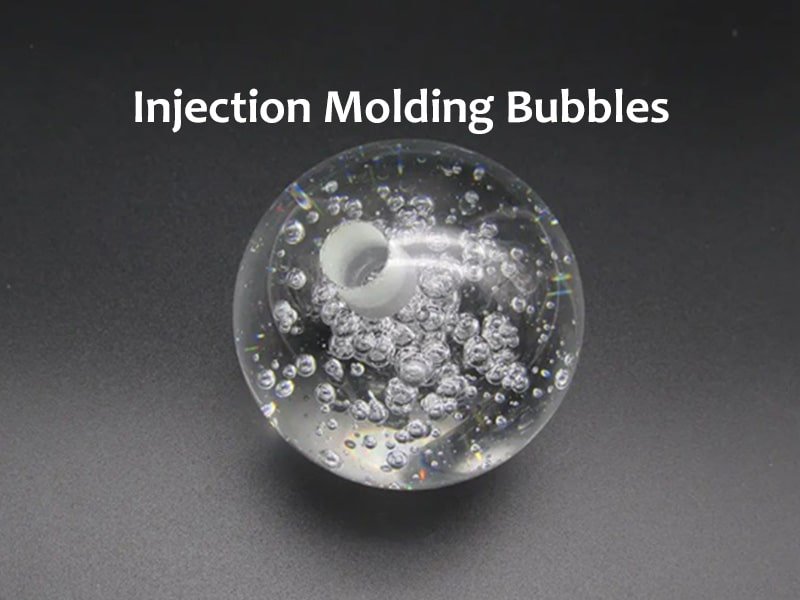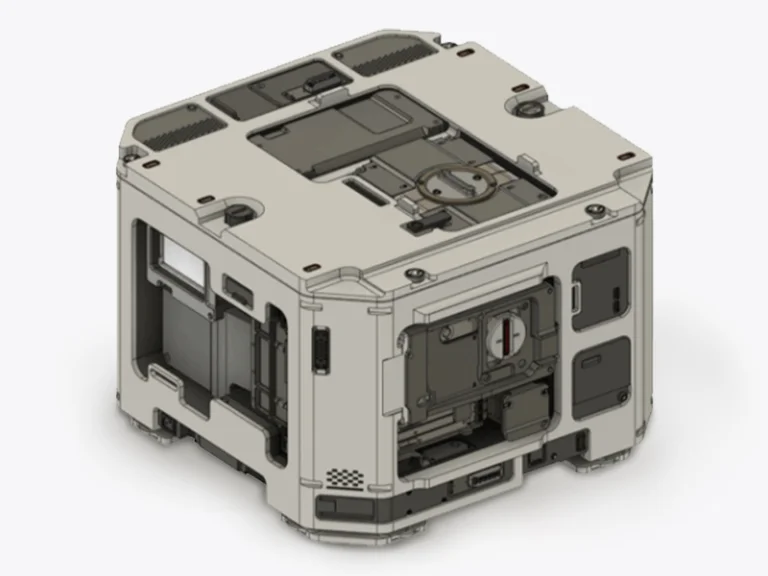Bosses in plastic design parts is a common design element in injection molding. It is offering a low-cost solution to align and strengthen parts. They also serve as connection points that hold different parts of a product together. Despite their seemingly simple appearance, injection molding boss design in plastic parts requires careful consideration to meet both functional and cosmetic requirements. Proper boss design in plastic parts is crucial for ensuring the overall performance and aesthetic quality of the final product.
What is a Bosses in Plastic Design Parts?
- Bosses in Plastic Design
A boss design in plastic parts is a cylindrical protrusion typically used for mounting, fastening, alignment, or reinforcement purposes. Typically, a boss with a hole in the center to install a screw, an insert, or a threaded fastener.
Boss Design in Plastic Parts Applications and Purposes
Bosses Applications for Different Purposes:
Mounting Points: Bosses act as mounting locations where parts are attached to other components, ensuring proper positioning and secure attachment.
Assembly Features: They facilitate the alignment and connection of multiple parts, ensuring that parts fit together accurately during assembly and making assembly processes more efficient and reliable.
Fastening Locations: Plastic screw boss design provides reinforced areas or secure points for inserting screws or other fasteners, ensuring that the fasteners hold firmly without causing damage to the plastic part.
Electrical Component Mounting: In electronics, bosses are often used to hold circuit boards or other components in place within a plastic enclosure. Adding structural support to thin or weak sections of the part.
Hinge Support: In products with moving parts, bosses can serve as pivot points or hinge supports, allowing for smooth and durable movement.
What is a Boss Thickness in Plastic Parts?
Boss thickness refers to the wall thickness of a boss feature in plastic parts, which is critical for ensuring structural integrity and minimizing defects during the injection molding process.
Recommended General Thickness Range: The wall thickness of a boss injection molding should ideally be between 40% to 60% of the nominal wall thickness of the part. This range helps to minimize issues such as sink marks and voids that can occur when bosses are too thick.
Maximum Thickness: It is generally advised that the injection moulding boss wall thickness should not exceed 75% of the main wall thickness. Exceeding this can lead to increased cycle times and potential defects during cooling.
Base Radius: The radius at the base of the boss injection molding should be at least 25% of the main wall thickness or a minimum of 0.4 mm to promote better mold flow and reduce stress concentrations.
Design Guideline for Molded Plastic Parts
- Boss Design Guideline
Here are 10 essential boss design guidelines to follow in plastic parts design, to ensure optimal functionality and manufacturability:
- Minimum Radius at Base of Boss
Minimum Radius at Base of Boss: The intersection of the base of the boss with the nominal wall is typically stressed and stress concentration increases if no radii are provided. Ensure a minimum radius at the base of the boss to reduce stress concentrations. A recommended radius is between 0.25 to 0.5 times the nominal wall thickness.
- Spacing between Bosses
Spacing between Bosses: When bosses are placed very close to each other, it results in creating thin areas that are hard to cool and can affect quality and productivity. So, maintain adequate spacing between bosses to prevent thick areas that can complicate cooling and affect product quality. A minimum spacing of at least two times the nominal wall thickness is advised.
- Radius at Base of Hole in Boss
Radius at Base of Hole in Boss: Incorporate a radius at the base of holes in bosses to avoid sharp corners, which can lead to stress concentrations. It is recommended that the radius at the base of the hole in the boss should be 0.25 to 0.5 times the nominal wall thickness.
- Minimum Draft for Boss OD
Minimum Draft for Boss OD: An appropriate draft on the outer diameter of a boss helps easy ejection from the mold. Apply a minimum draft angle on the outer diameter (OD) of the boss to facilitate easy removal from the mold. The recommended draft angle typically ranges from 1 to 3 degrees.
- Minimum Draft for Boss ID
Minimum Draft for Boss ID: Similarly, ensure a minimum draft on the inner diameter (ID) of the boss to support proper engagement with fasteners and easier extraction from the mold. It is recommended that minimum draft on the hole in boss should be greater than or equal to 0.25 degree.
- Proper Boss Height
Boss Height to OD Ratio: Maintain a height-to-outer diameter ratio for bosses, ideally not exceeding three times its diameter, to prevent cooling difficult and extending the cycle time.
- Minimum Radius at Tip of Boss
Minimum Radius at Tip of Boss: Design a minimum radius at the tip of the boss to enhance strength and reduce potential stress points during assembly or use.
Chamfer at the Top of Boss: Include a chamfer at the top of the boss to facilitate screw installation and improve overall assembly efficiency.
- Wall Thickness of Bosses
Wall Thickness of Boss: The wall thickness should be between 40% to 60% of the nominal wall thickness of the part, ensuring sufficient strength while minimizing sink marks and warping. If the boss is not in a visible area, the wall thickness can be increased to allow for increased stresses imposed by self-tapping screws.
- Standalone Bosses
Standalone Boss: Avoid designing bosses as isolated features; they should be connected to adjacent walls or ribs for enhanced strength and better material flow during injection molding.
Optimize Plastic Boss Design to Eliminate Structural Failure and Cost Waste!
Key Considerations for Boss Design in Plastic Parts
Here are the key considerations for injection molding boss design in plastic parts:
Wall Thickness and Strength: Design boss walls to be 40-60% of the nominal wall thickness, balancing the need for fastener holding strength with the risk of sink marks, while ensuring sufficient material for thread engagement in threaded bosses.
Height and Cooling: Optimize boss injection molding height to provide adequate strength without excessive material, considering that taller bosses require longer cooling times, which can affect dimensional accuracy and cycle times.
Placement and Reinforcement: Connect bosses to nearby walls with ribs when possible for improved rigidity and material flow, but avoid placing them directly in corners; for isolated bosses, consider using gussets for reinforcement without thickening walls.
Draft angles and Ejection: Incorporate draft angles on both inner and outer walls of the boss to facilitate easy ejection from the mold, preventing damage or breakage during part removal.
Fillets and Stress Reduction: Include fillets in your injection molding boss design to eliminate sharp corners, reduce stress concentrations and improving material flow patterns.
Material shrinkage Management: Account for the shrink rate of the chosen material when determining boss dimensions, managing uneven cooling to prevent sink marks, warping, and internal stresses.
Cooling and Cycle Time: Balance boss design with cooling requirements, as thicker sections take longer to cool, affecting cycle time and dimensional accuracy.
Structural Integrity and Load Bearing: Design bosses to withstand both assembly forces and service loads, considering reinforcement methods like gussets or connecting ribs when necessary.
Cosmetic Considerations: Balance functional needs with cosmetic requirements, especially for visible bosses, by managing sink marks and surface defects through proper design choices.
Common Mistakes to Avoid When Design Plastic Parts Boss
Insufficient Draft Angle
One of the most common mistakes in injection molding boss design is neglecting to include an adequate draft angle. A draft angle facilitates the easy ejection of the part from the mold, reducing the risk of damage or deformation. Insufficient draft angles can result in:
Difficult Part Ejection: Increasing the likelihood of part damage during removal from the mold.
Surface Defects: Causing imperfections and poor surface finish.
Need Higher Ejection Forces: Leading to increased stress on both the part and the mold, potentially causing damage.
Inadequate Support Leading to Boss Failure
Bosses need proper support to maintain their structural integrity. Failing to provide adequate support can result in boss failure, which manifests as:
Weak Fastening Points: Causing screws or other fasteners to strip or pull out.
Part Deformation: Leading to misalignment and compromised functionality.
Increased Stress: Concentrating stress at the base of the boss, leading to cracks or breaks.
To avoid these issues, ensure bosses are adequately supported with ribs or gussets, especially if they are located far from side walls.
Overlooking Cooling Time Impact on Boss Strength
Cooling time is a crucial factor that directly impacts the strength and dimensional accuracy of bosses. Overlooking this aspect can lead to:
Inconsistent Dimensions: Resulting from uneven cooling, causing the boss to shrink or warp.
Weakened Structure: Due to insufficient cooling time, which can affect the mechanical properties of the boss.
Extended Cycle Times: Increasing production costs and reducing efficiency.
Designers should account for cooling time in their injection molding boss design, ensuring the core pin and surrounding material cool evenly and sufficiently.
Ignoring the Flow of Material Around the Boss During Molding
The flow of material around the boss injection molding during the molding process is critical for achieving a defect-free part. Ignoring this can lead to several issues, including:
Incomplete Filling: Resulting in voids or air pockets within the boss.
Flow Lines: Causing surface defects and weakened areas in the part.
Weld Lines: Forming where the material flow fronts meet, potentially reducing the boss’s strength.
To prevent these issues, ensure the material flows smoothly around the boss by incorporating appropriate fillets, avoiding abrupt changes in wall thickness, and optimizing the placement and orientation of the boss within the mold.
Conclusion Bosses in Plastic Design
Proper bosses design in plastic parts is crucial for the structural integrity, functionality, and aesthetic quality of plastic molded parts. They serve essential roles in aligning, strengthening, and fastening components, making them indispensable in various applications. Proper injection molding boss design minimizes defects such as sink marks, warping, and inadequate fastening, ensuring that the final product performs reliably and looks appealing. By following these guidelines, designers can create effective and efficient boss designs in plastic parts, leading to higher-quality products and more reliable manufacturing processes.















